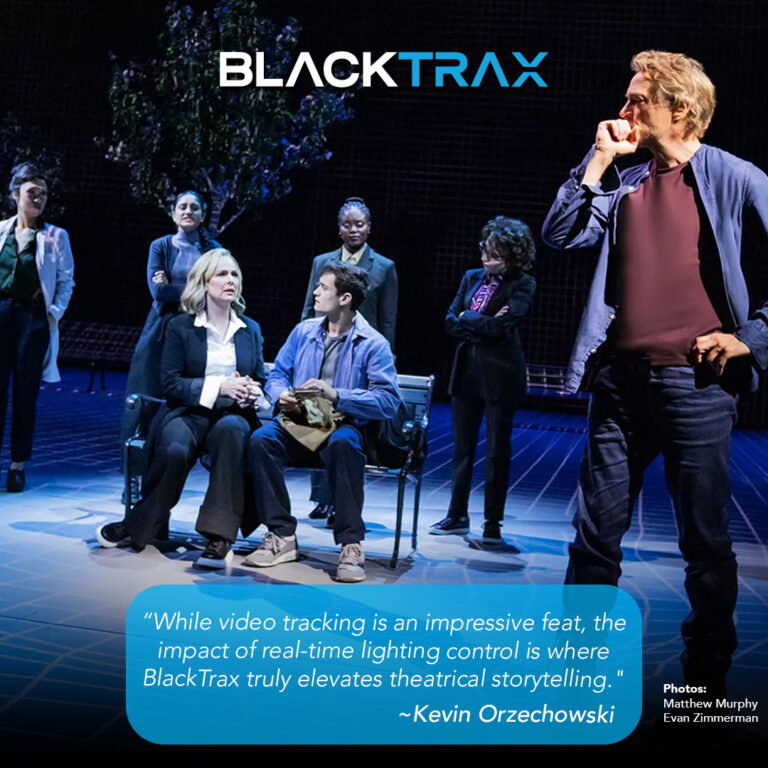
Kevin Orzechowski’s journey with Lincoln Center Theater began in 2016, after honing his craft in the Production Department at The Juilliard School and years of freelance work in summer theater and national tours. Now an Associate Production Manager, Kevin played a key role in bringing McNEAL – a daring and thought-provoking play – to life. Commissioned by Lincoln Center Theater and written by Ayad Akhtar at the request of Artistic Director Andre Bishop, the play’s inspiration struck Akhtar in a dream. That vision evolved into a story that explores the intersection of human creativity and artificial intelligence, with McNEAL, a fictional, long-overlooked author, finally gaining literary fame with a work secretly co-written by AI. The play’s narrative artfully blurs the line between human and machine-driven storytelling, leaving audiences questioning the very nature of authorship.
The journey of bringing this production to life began years ago, with the script slowly taking shape over time. It wasn’t until late spring 2024 that the story was ready for its first table read. Once the script was set, the set design had to come first, laying the groundwork for lighting, sound, and video design.
The set, a collaboration between designers Michael Yeargan and Jake Barton, drew inspiration from the shape of an iPhone – smooth, minimalistic, and modern. Jake’s background in video production brought a fresh perspective, with LED walls and soft-edged panels transforming the stage into a digital canvas. The show’s opening scene featuring McNEAL texting an AI reminiscent of ChatGPT, immediately immersed the audience in this fusion of technology and art.
At the heart of the play is a powerful emotional core, particularly in its sixth scene, where McNEAL confronts his past in a deeply human reckoning. While the experimental nature of McNEAL sparked mixed reactions, its ambition and striking themes left a lasting impression.
“BlackTrax offered an unmatched level of flexibility, making it easier to create dynamic, responsive environments on stage.”
The Integration of BlackTrax

Jake Barton came into McNEAL with bold plans for BlackTrax, aiming to create highly interactive, real-time content that would push the boundaries of stage design. Lighting designer Don Holder hadn’t initially planned to use BlackTrax, but after a successful project in China titled, The Great Qin, where he implemented the system across a 600 ft stage to track intricate flight choreography, he was eager to explore its potential when it became available for McNEAL.
BlackTrax offered a game-changing opportunity: it allowed moving lights to track performers in real-time, reaching them in moments when traditional spotlights couldn’t. As technical rehearsals progressed, the practical constraints of time shaped how the system was ultimately used. Jake chose a few key moments where his animations would be directly influenced by BlackTrax, creating an interplay between movement and design. Don, on the other hand, embraced the system more extensively. With the play unfolding across seven distinct locations, traditional follow spots fell short. In scene six, when six simultaneous spotlights were needed but only two operators were available, BlackTrax stepped in, seamlessly tracking and highlighting multiple performers, creating a fluid and flexible lighting environment that wouldn’t have been possible otherwise.
BlackTrax added a new layer of sophistication and while there was a bit of a learning curve at first, the team became familiar with how BlackTrax worked with other production elements. Jake’s vision demanded that the system’s tracking capabilities align perfectly with the show’s themes, allowing animation to respond directly to the actors’ movements on stage. This level of real-time interactivity is rarely achieved in theater and it wouldn’t have been possible without the incredible support from both the CAST Group team and Carbon Arc Projects Inc. teams (provider of Pro Audio, Video, and Communications services). Both played a crucial role in collaborating with the design team. Together, they efficiently programmed the system, ensuring it was seamlessly up and running on schedule.
While the video component’s seamlessness made its magic almost invisible, with audiences often unaware that the animations were reacting live to the actors, the system’s real strength shone through in the lighting design. BlackTrax offered an unmatched level of flexibility, making it easier to create dynamic, responsive environments on stage. As the McNEAL team discovered, while video tracking is an impressive feat, the impact of real-time lighting control is where BlackTrax truly elevates theatrical storytelling.